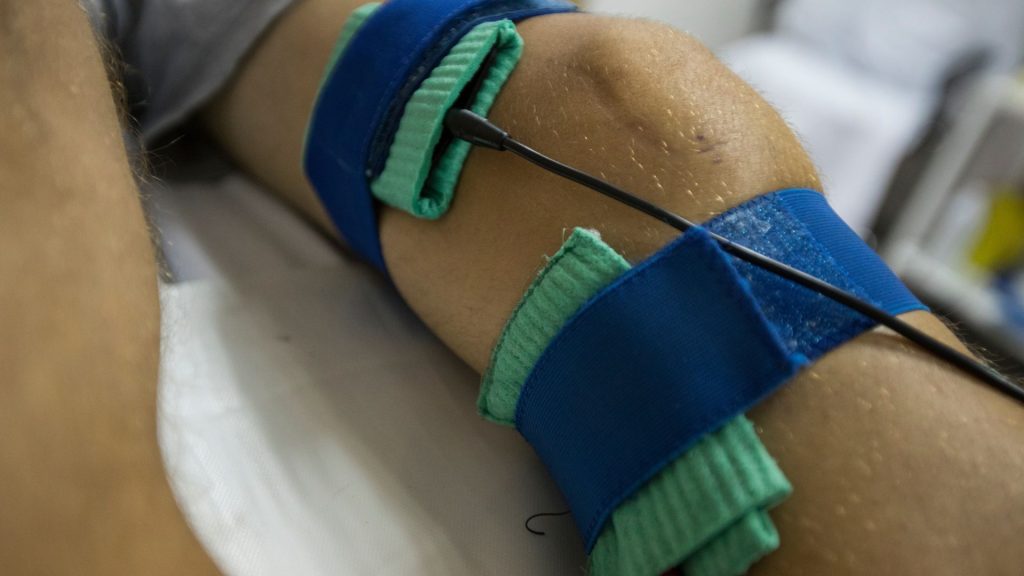Many of us know the discomfort all too well – that sharp sting in the knee during a game, or even just while taking a stroll. It’s unsettling, to say the least. That’s exactly what spurred our deep dive into everything about knee braces.
Interestingly enough, research highlights their benefits, especially for individuals under 17.
We’re eager to share our findings with you. From types designed for ACL injury prevention to those aimed at stabilizing and healing your knee post-surgery, it turns out there’s quite a variety to choose from.
Our article will walk you through how these braces not only protect your knees but also aid in pain relief, empowering you to embrace your favorite activities once again without fear—excited? Continue reading!
Understanding Knee Braces
Knee braces support the knee joint during activity. They help protect ligaments and keep the knee stable.
Types of Knee Braces
We can find different types of knee braces. Each type serves a unique purpose and offers specific benefits.
Prophylactic Braces
These braces help prevent injuries. They support the knee during sports activities. Studies show they significantly protect younger patients from ACL injuries.
Functional Braces
After an injury, these braces provide support. They improve knee stability after surgery or ligament tears. We often wear them during recovery to regain strength.
Rehabilitation Braces
We use these after surgery for recovery. They limit movement while allowing some flexibility. Wearing this brace aids in ACL rehabilitation and helps restore function to the knee joint.
Unloader Braces
This type is designed for those with arthritis or pain on one side of the knee. It shifts weight away from the damaged part of the joint, improving comfort and mobility.
Orthotic Knee Supports
These are custom-made braces that fit our individual needs. They help align and stabilize the knee joint more effectively than standard options.
Knee Sleeves
Made from elastic material, they provide compression and warmth but do not offer rigid support like other types do. Many find them helpful for mild instability or as a preventive measure during activity.
ACL Braces
Specifically meant for protecting the anterior cruciate ligament, these braces restrict forward and rotational movement in the knee joint to prevent twisting or bending of the ligament after an injury.
Choosing the right brace depends on our needs and injury status. It’s essential to consult with a healthcare professional before deciding on any particular type of knee brace for effective post-surgery support or rehabilitation.
What Does a Knee Brace Do?
A knee brace supports the knee joint. It helps prevent movements that can cause further injury. By restricting forward, backward, and rotational movement, it protects the anterior cruciate ligament (ACL).
This is important for people who have had ACL injuries or surgery.
We know from studies that wearing a knee brace during activities can lower the risk of ACL injuries and reinjuries. Young patients aged 17 and younger benefit significantly from this support.
The right brace provides stability during sports or daily activities.
Knee braces also help improve overall knee function. They relieve symptoms like pain and stiffness. Many athletes use them to feel safer while playing sports after an injury or surgery on their ACLs.
In our experience, finding the best type of brace is key to effective recovery and protection for each person’s needs.
Benefits of ACL Knee Braces
ACL knee braces offer key benefits for people with knee issues. They help prevent injuries and boost stability during activities like sports.
ACL Injury Prevention
Knee braces can help prevent injuries to the Anterior Cruciate Ligament (ACL). Studies show wearing a knee brace during activity can lower the risk of ACL injury. This is especially true for younger athletes, aged 17 and under.
Many people find that these braces give them better knee stability during sports.
We see firsthand how effective these braces are in protecting ligaments. They limit movements that may twist or bend the ligament, which reduces stress on it. For those recovering from an ACL injury, using a brace can support healing and improve overall knee function.
Improved Knee Stability
To move from ACL injury prevention, we should look at improved knee stability. ACL knee braces play a key role in providing strong support to the knee joint. They help keep it stable during sports and other activities.
This is especially important for athletes who have had injuries or surgeries.
Research shows that wearing a knee brace can reduce the risk of further harm. Studies found that these braces protect younger patients well, especially those under 17 years old. The right type of brace restricts unwanted movement like twisting or bending.
This helps maintain proper alignment and strength in the knee area.
Our goal is to enhance our safety while being active. Many people find relief from pain and stiffness when using an ACL brace. We can enjoy our favorite sports with better confidence knowing our knees are more stable during activity.
Ligament Protection
Knee braces play a key role in ligament protection. They help guard the anterior cruciate ligament (ACL) from injury. Studies show that knee braces can be effective at preventing ACL injuries, especially in younger patients aged 17 and under.
Wearing a brace during activities can limit movement that might lead to damage or reinjury.
Different types of ACL braces restrict forward, backward, and twisting movements. This helps keep the knee stable during sports or daily activities. Patients often wear these braces after an ACL tear or surgery for essential support.
We have seen firsthand how they aid recovery and improve joint stability when used as recommended by orthopedic surgeons.
Choosing the right type of knee brace is crucial for individual needs. Each person may require different features based on their specific conditions and activity level. Next, we will discuss enhanced post-surgery support provided by these braces.
Enhanced Post-Surgery Support
After ACL surgery, wearing a knee brace offers strong support for the healing process. It helps keep the knee joint stable and protects the ligament from additional injury. Patients may need to wear an ACL rehabilitation brace during sports or even while sleeping, as recommended by their orthopedic surgeon.
Using a knee support brace can also relieve pain and stiffness after surgery. This added comfort allows us to focus on recovery and regain strength in our knees. Studies show that braces improve knee function and help protect against reinjury, making them essential for effective post-surgery care.
Effectiveness of Knee Braces
Knee braces can help improve knee function and support after an ACL injury or surgery. They offer stability during sports and daily activities. Many people find that wearing a brace boosts their confidence in movement.
If you’re curious about how knee braces work, read on to learn more!
Effectiveness in Improving Knee Function
Using ACL knee braces can significantly improve knee function. Studies show that wearing these braces during activity helps prevent injuries, including ACL tears. They support the knee and can protect against reinjury.
Different types of ACL braces work in various ways. Some restrict movement in the knee joint to stop twisting or bending that could harm the ligament. This added stability allows us to move more freely while reducing pain and stiffness.
People recovering from an ACL injury often benefit from these braces. Patients may need to wear them for a specific time during sports or even while sleeping, as suggested by their orthopedic surgeon.
This extra support helps improve overall knee stability and aids recovery after surgery.
Effectiveness in ACL Reconstruction
Knee braces can play a key role in ACL reconstruction. They help support the knee after surgery. We found that wearing an ACL brace during activity can protect against reinjury. These braces limit forward, backward, and rotational movement in the knee joint.
This restriction helps prevent twisting or bending of the ligament.
Studies show that they are especially effective for younger patients, those aged 17 years and under. The right type of brace can improve knee function and stability as we recover from an injury or surgery.
Consulting with a healthcare professional is crucial to find the best option for each person’s needs.
After discussing their effectiveness in ACL reconstruction, we will explore how well these braces help with overall knee function improvement.
Conclusion
We learned that ACL knee braces can provide support and protection. They help prevent injuries and stabilize the knee during activities. Many studies show their effectiveness, especially in younger patients.
Choosing the right brace is key to recovery after surgery or an injury.
For more information, we can consult healthcare professionals about our specific needs. Taking care of our knees now will lead to better movement later on! Let’s stay active and protect our joints when playing sports or exercising.
FAQs
1. What is an ACL knee brace and how does it work?
An ACL knee brace, also known as a ligament protection brace or knee orthosis, is designed to provide support and stability to the anterior cruciate ligament (ACL). It helps in maintaining knee joint stability and range of motion during activity.
2. Can an ACL Knee Brace prevent further injury?
Yes, using a knee stability brace after a knee injury can help in preventing further damage. Sports medicine experts often recommend them for added support during physical therapy sessions.
3. Is an ACL Knee Brace effective post-surgery?
Post-surgery knee support is crucial for recovery. An anterior cruciate ligament brace can improve your comfort levels by providing needed stability and reducing pain.
4. How does an ACL Knee Brace enhance my sports performance?
A well-fitted ligament protection brace improves your confidence while playing sports by enhancing your knee’s stability during high-intensity activities, thus helping to prevent injuries.
5. Does wearing an ACL Knee Brace restrict my movement?
No! A good quality anterior cruciate ligament brace will not limit your range of motion but rather facilitate mobility while ensuring your safety post-injury or surgery.



